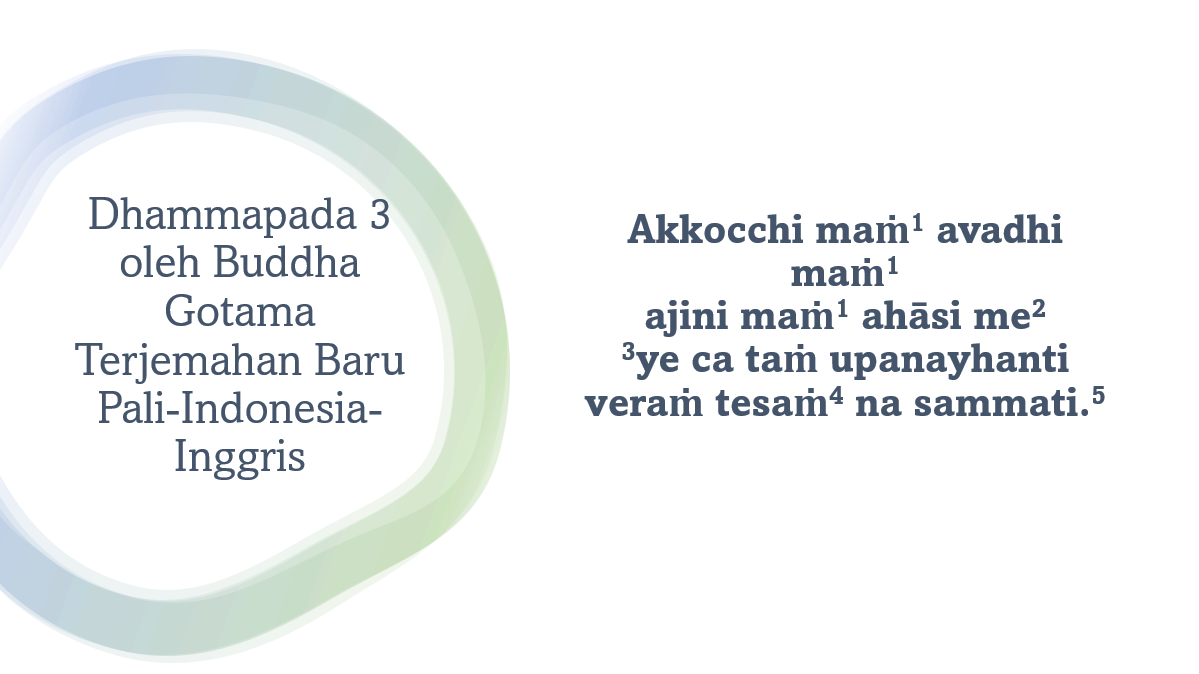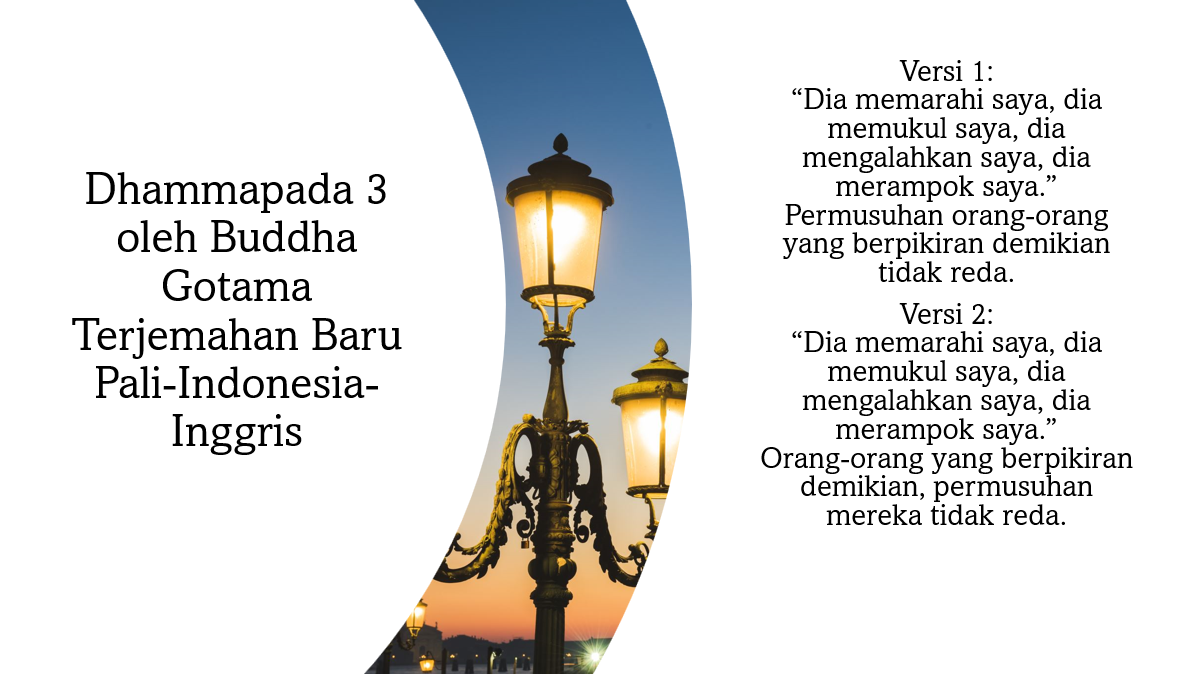Yamaka Vagga



Vocabulary 1 |
Vocabulary 2 |
akkocchi (3rd sg. pers. aor. of √kus ‘to abuse’ = abused.avadhi (3rd sg. pers. aor. of √vadh ‘to strike’ = struck.ajini (3rd sg. pers. aor. of √ji ‘to conquer’= (he) conquered.ahasi: (3rd sg. pers. aor. of √har ‘to carry away, to rob’ = (he) took away, robbed; (ii) third person singular ahāsi (from the root har ‘to take away’ (Geiger, 2005:159)ye (pl. masc. nom. of the demonstr. pron. ya (who, which’ = who, which |
taṁ (sg. masc. acc. of the demonstr. pron. ta ‘it, that’ = it, thatveraṁ: vera (nt.) =hatred. veraṁ (nom. sg.) = hatredtesaṁ (pl. masc. gen.. of the demonstr. pron. ta (it, that’ = theirna (indec. part.) = no, notsammati (3rd sg. pers. pres.. indic. act. of √sam ‘to be appeased’= is appeased (Sarao, 2009:4-5) |
Pali Grammar
1maṁ: me, accusative case
2 me: (i) Presumably me is ablative, he took from me, he robbed from me. (Anandajoti, www.ancient-buddhist-texts.net); (ii) genitive case, ‘my (belongings)’ (Sarada,1993:68 & Na, 2020:22); (iii) genitive case (Rozehnal,ibid., Stanza 3); (iv) the form me, of the genitive, dative, instrumentative, and ablative, singular cases, is enclitic; it is never used at the beginning of a sentence (Duroiselle, 1915/1997, No.289.b); (vi) not found as any case (Tilbe, 1899:59-60); (vii) me= mama, genitive case of the first person pronoun; variant ahaṁ; -‘me= ime (Andersen: 1907, 1996 :210); (viii) the enclitic forms me and te are the instrumentative, dative, and genitive cases of the first person singular (E.Muller, 1884:86-87); (ix) sg. gen. of 1st pron. ahaṁ ‘I’ = mine (Sarao, 2009:5)
3(a)We might have expected the genitive, not the nominative, form here, yesaṁ, for those…, the line could easily be rewritten to fit the metre: yesañ-ca upanayhanti, and in the next line: yesaṁ na upanayhanti (Anandajoti, www.ancient-buddhist-texts.net); (b)(1) upanayhanti (3rd pl. pers.pres.. indic. act.; upanayhati, 3rd sg. pers. pres.. indic. act.), derived from upa (pf. meaning ‘close by, near’+√nah ‘to bind’= bind themselves to, to bear;’ (2) upa- + nah- +-ya + -nti = upanayhanti, as written by Duroiselle (1915/1997:20, No.78) that when y follows h, a metathesis, the transposition of letters, takes place:
(i) √sah+ya=sahya, and by metathesis = sayha ‘to be conquered, to be defeated, to be overcome;’ (sahati ‘to conquer, to defeat, to overcome)
(ii) √guh+ya=guhya=guyha ‘to be hidden;’ (guhati ‘to hide, to conceal’).
Note: Perniola (1997:142©) writes that the suffix -ya has been used to form the future participle passive. It is usally, though not always, added to the root in its guṇa (or strengthening) grade:
bhid-ya > bhed-ya > bhejja ‘to be broken;’ bhuj-ya > bhoj-ya > bhojja ‘to be eaten;’ bhu-ya > bhav-ya > bhabba ‘to be capable of;’
han-ya > hañña ‘to be killed;’
√guh+ya > guhya > guyha ‘to be hidden.’
(3) nayhati: to tie, to bind; Davids (1921-1925/2005: 183, Part IV) writes that nayhati is used only in compounds with the preposition upa- as upanayhati.
5 sammati: 3rd sg. pers. pres. act. indic. of √sam ‘to be appeased,’ a passive voice; sammanti 3rd pl. pers. pres. act. indic.; causative sameti ‘to cause to calm;’ past part. santa

Perbandingan 4 terjemahan
| English 1: Sarada |
English 2: Carter & Paliwahadana |
| Who bears within them enemity; “he has abused and beaten me, defeated me and plundered me”, hate is not allayed for them. | ‘He reviled me! He struck me! He defeated me! He robbed me!’ They who gird themselves up with this, For them enmity is not quelled. |
| Indonesia 1: BDG |
Indonesia 2: CDD |
| “Ia mencela saya, ia memukul saya, ia mengalahkan saya, ia merampok saya.” Barangsiapa menyimpan pikiran demikian, kebencian takmungkin reda. | Dia mencelaku, dia memukulku, dia mengalahkanku, dia merampas milikku. Pada mereka yang menanggung rasa benci terhadap hal tersebut, kebenciannya tidak akan* menjadi reda.
*In English and Indonesian, this auxiliary verb should not be used, as this stanza refers to what is an eternal, or general, or universal, truth (https://byjus.com/question-answer/give-some-examples-of-universal-truth/) |
Mari teman-teman pilih mana yang paling benar. Tulis komentar di bawah ini ya….



